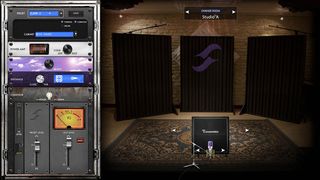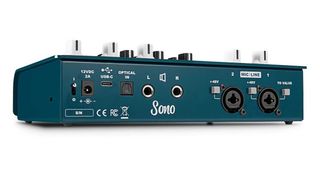
Sono is Audient’s latest offering in the audio interface market. Created in partnership with cabinet simulation experts Two Notes, Sono offers guitarists, musicians and engineers a flexible and full featured audio interface that gives you great guitar tones as well as the sound quality that you would expect from an Audient interface.
Here are five reasons why Sono could well be the ideal audio interface for guitarists...
1. Record. Jam. Perform
Whether you are wanting to record your ideas, need a device to let you practise guitar at the dead of night without annoying your neighbours, or want something to take with you to a gig instead of dragging around a massive cab, Audient’s Sono has been designed to cater for your needs, while allowing a great deal of flexibility for individual needs.
2. Tube preamp
For guitarists, bassists and anyone else that wants to make use of some interesting tonal features, Sono employs a full voltage 12AX7 valve preamp in the instrument input, offering warm analogue tones straight off the bat.
This is then sent into the 3-band EQ and to the Two Notes processing, in the form of power amp and cabinet simulation, all of which can be controlled on the accompanying Two Notes Torpedo software.

3. Onboard DSP
The Two Notes software allows you to model a huge range of classic guitar and bass cabs in a number of different environments, with a number of different microphones, and the best thing? It’s all processed on Sono itself, within the internal DSP, so it is completely latency free!
Once you have found a tone you like, you are able to store it on Sono and recall it at any point, whether you have a computer plugged in or not. You can store up to three presets onboard and toggle between them by simply pressing the C.A.B button on the top of the unit.
4. Re-amping
For those that might want to record the sound of their own cab, Audient have made sure to include a re-amp output, meaning you can run pre-recorded audio from your recording session back into your amp, then record it back in to your session by miking up the real life amp.
This is made especially easy to do seeing as you are able to record a clean DI and Two Notes processing simultaneously, letting you play with latency free cab simulation, but giving you the option to re-amp the clean signal at a later date should you need.
Now you can make sure you nail the performance, but still have the flexibility to change your amp sound at a later date if you’d like.

5. An audio interface at heart
Sono is still a solid choice for any type of musician or engineer whether or not you play guitar or bass. In terms of inputs, it has two Audient console mic preamps, one of which can be routed through the valve and/or Two Notes processing, letting you create some interesting effects, or just adding some analogue warmth to your recordings.
For those wanting to record more channels, there is an optical input allowing you to expand Sono up to a total of ten input channels when connecting to an eight channel mic pre unit. High spec AKM converters feed a pair of line outputs for speakers as well as a high power headphone output, with controls on the top of the unit, and a convenient “Monitor Mix” knob allowing you to blend what you hear between the zero latency input (whether your mic pre or Two Notes processing), and whatever you are playing from your DAW or computer.
To find out more about Sono on the Audient website.
Get the MusicRadar Newsletter
Want all the hottest music and gear news, reviews, deals, features and more, direct to your inbox? Sign up here.